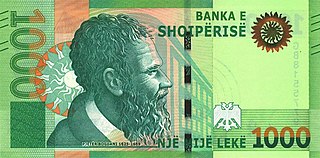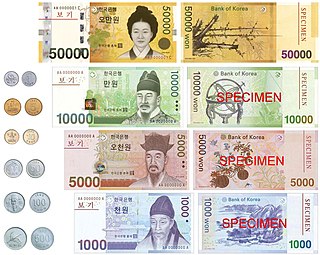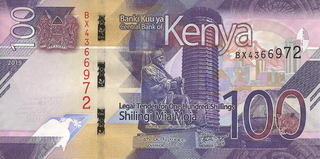Related Research Articles
The renminbi is the official currency of the People's Republic of China. It is the world's 5th most traded currency as of April 2022.

The Mexican peso is the currency of Mexico. Modern peso and dollar currencies have a common origin in the 16th–19th century Spanish dollar, most continuing to use its sign, "$".

The lek is the currency of Albania. Historically, it was subdivided into 100 qintars.
The Korean People's won, more commonly known as the North Korean won and sometimes known as the Democratic People's Republic of Korea won, is the official currency of North Korea. It is subdivided into 100 chon. The currency is issued by the Central Bank of the Democratic People's Republic of Korea, based in the North Korean capital city of Pyongyang.

The South Korean won is the official currency of South Korea. A single won is divided into 100 jeon, the monetary subunit. The jeon is no longer used for everyday transactions, and it appears only in foreign exchange rates. The currency is issued by the Bank of Korea, based in the capital city of Seoul.
The Hong Kong dollar is the official currency of the Hong Kong Special Administrative Region. It is subdivided into 100 cents or 1000 mils. The Hong Kong Monetary Authority is the monetary authority of Hong Kong and the Hong Kong dollar.
The New Taiwan dollar is the official currency of the Republic of China. The New Taiwan dollar has been the currency of the island of Taiwan since 1949, when it replaced the old Taiwan dollar, at a rate of 40,000 old dollars per one new dollar. The basic unit of the New Taiwan dollar is called a yuan (圓) and is subdivided into ten chiao (角), and into 100 fen (分) or cents, although in practice both chiao and fen are never actually used.

The Malaysian ringgit is the currency of Malaysia. It is divided into 100 sen. The ringgit is issued by the Central Bank of Malaysia.

The Macanese pataca or Macau pataca is the currency of the Macao Special Administrative Region of the People's Republic of China. It is subdivided into 100 avos, with 10 avos called ho (毫) in Cantonese.

The Manchukuo yuan was the official unit of currency of the Empire of Manchuria, from June 1932 to August 1945.

The shilling is the currency of Kenya. It is divided into 100 cents. The Central Bank of Kenya Act cap 491, mandated the printing and minting of the Kenyan shilling currency.

The history of Chinese currency spans more than 3000 years. Currency of some type has been used in China since the Neolithic age which can be traced back to between 3000 and 4500 years ago. Cowry shells are believed to have been the earliest form of currency used in Central China, and were used during the Neolithic period.
The Yuan is the base unit of a number of former and present-day currencies in Chinese.
The first series of Renminbi banknotes was introduced during the Chinese Civil War by the newly founded People's Bank of China on December 1, 1948, ten months before the founding of the People's Republic of China itself. It was issued to unify and replace the various currencies of the communist-held territories as well as the currency of the Nationalist government.
The second series of Renminbi banknotes was introduced on March 1, 1955. Together with the introduction of the second series, the decimal point was moved 4 places to the left. As a result, one first series ¥10,000 note is equivalent to one second series ¥1 note.
The third series of Renminbi banknotes was introduced since April 15, 1962. Unlike the second series of the renminbi, it did not have a ¥3 banknote and added ¥0.1, ¥0.2, ¥0.5 and ¥1 coins. For the next two decades, the second and third series banknotes were used concurrently. The third series was phased out over the 1990s and then was recalled completely on July 1, 2000, a date valid for all of the denominations with only one date provided.
The fifth series of the renminbi is the current coin and banknote series of the Chinese currency, the renminbi. They were progressively introduced since 1999 and consist of ¥0.1, ¥0.5, and ¥1 coins, and ¥1, ¥5, ¥10, ¥20, ¥50, ¥100 notes. The ¥20 banknote is a new denomination, and was added in this series. All banknotes in this series feature a portrait of Chinese Communist Party chairman Mao Zedong by artist Liu Wenxi. Therefore, this series of banknotes is also known as "Grandpa Mao" among the people.

The đồng was the currency of North Vietnam from 3 November 1946 to 2 May 1978. It was subdivided into 10 hào, each itself divided into 10 xu.

The Da-Qing Bank was a state-controlled entity established by the Qing dynasty in 1905 to serve as Imperial China's first central bank. It issued banknotes that were intended to unify the Qing dynasty's currency system. In 1912 following the Xinhai Revolution, the Bank of China was created to take over the role of the Da-Qing Bank, which was liquidated in an orderly manner.

The banknotes of the Da-Qing Bank were intended to become the main form of paper money of the Qing dynasty following the bank's establishment in 1905. The Da-Qing Bank had branches throughout China and many of its branches outside of its headquarters in Beijing also issued banknotes.
References
- ↑ "Summary of currency for People's Republic of China". People's Bank of China. 8 May 2006. Retrieved 20 January 2014.
- ↑ "再见,第四套人民币". Xinhuanet.com. 2019-04-29. Archived from the original on April 29, 2019.
实际上,1角、5角纸币仍可流通,银行仍在正常收付,单位和个人不得拒收。
- ↑ "中国人民银行公告〔2018〕第6号". People's Bank of China. 2018-03-22. Retrieved 2018-03-22.

